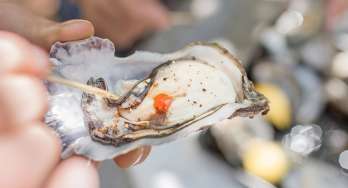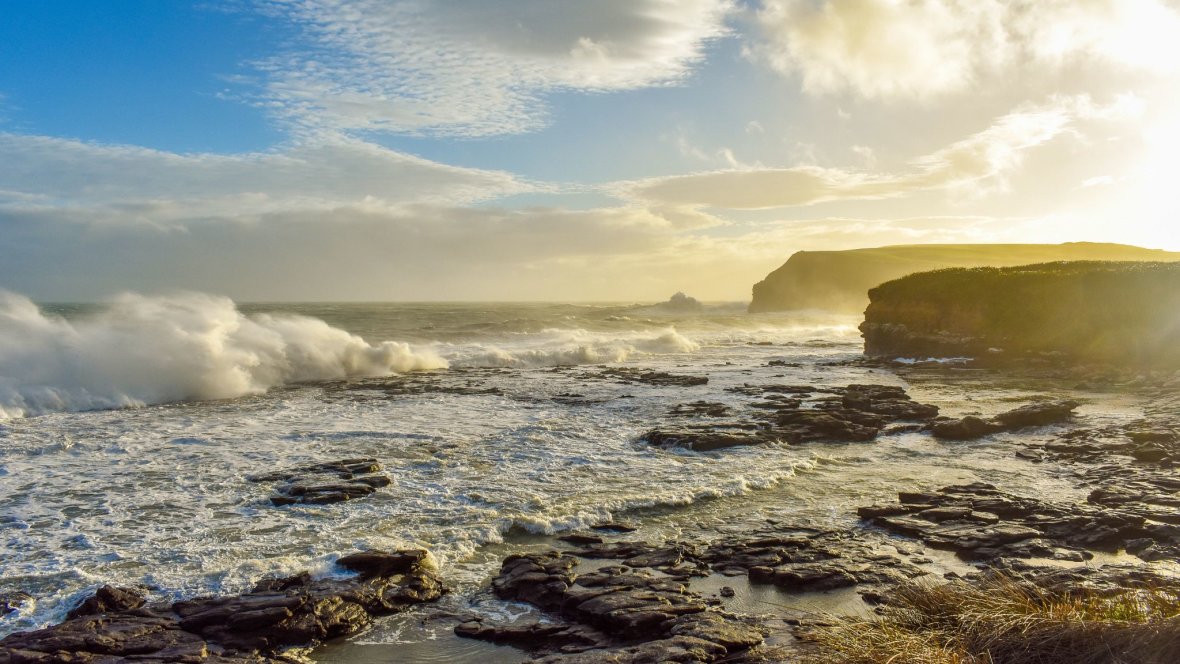


Join thousands of fellow campervan travellers
Sign up for our Britz newsletter to receive inspirational travel content and awesome deals, and we'll send you a copy of our Ultimate RV guide!
Thanks
Please confirm subscription in your email.
Is Curio Bay worth visiting?
Absolutely. This is a place where nature takes centre stage, with dramatic coastal views, rich history, and unforgettable wildlife encounters. It’s off the beaten track, quieter than many of New Zealand’s big-name destinations, and all the better for it.
Why is Curio Bay famous?
Curio Bay is best known for its petrified forest — one of the most well-preserved Jurassic fossil forests in the world. At low tide, you can walk among ancient tree stumps and fallen logs that have been transformed into stone over 180 million years. This incredible natural wonder is what gives the petrified forest at Curio Bay its global significance. But it’s not just history that makes this place special — it’s also a wildlife hotspot, home to rare yellow-eyed penguins, playful Hector’s dolphins, and even the occasional sea lion basking on the shore.
What is there to do in Curio Bay?
Curio Bay isn’t just a destination — it’s an experience. This rugged stretch of coastline is perfect for those who love wild, untouched landscapes and incredible wildlife encounters. Beyond the famous petrified forest, the area is packed with things to see and do. Walk the windswept beaches, explore the rock pools, or take in the panoramic ocean views from the clifftops. Nearby, Porpoise Bay offers safe swimming and surfing, and just a short drive away, you’ll find more Catlins gems like McLean Falls and the iconic Nugget Point Lighthouse. But for many, the real highlight is the chance to see yellow-eyed penguins and Hector’s dolphins up close.
Where to see Curio Bay penguins
Curio Bay is one of the best places in New Zealand to see hoiho, or yellow-eyed penguins, one of the world’s rarest penguin species. The best time to spot them is early morning or late afternoon, when they return from a day of fishing at sea. Head to the viewing platform near the petrified forest at sunset, and you might just see these incredible birds waddling ashore. Be sure to keep a respectful distance — hoiho are highly endangered, and staying quiet helps protect them.
Where to see dolphins in Curio Bay
For a chance to see Hector’s dolphins, head to Porpoise Bay, right next to Curio Bay. These playful little dolphins, found only in New Zealand, often swim close to shore, especially in the warmer months from November to March. If you’re lucky, you might see them surfing the waves or even swimming alongside visitors in the water. Whether you’re watching from the beach or taking a dip, seeing these rare dolphins in their natural habitat is a moment you won’t forget.

How to get to Curio Bay
Curio Bay is tucked away on the Catlins coast, making the drive part of the adventure. Whether you’re coming from Dunedin or Invercargill, expect winding coastal roads, breathtaking viewpoints, and plenty of reasons to pull over along the way. Travelling by campervan is the best way to explore, giving you the freedom to stop at scenic lookouts, take detours to waterfalls, and truly soak in this rugged part of New Zealand.
Dunedin to Curio Bay
The drive from Dunedin to Curio Bay takes around three and a half hours (165 km), but with so many great stops along the way, you’ll want to allow extra time. The route follows the Southern Scenic Route, passing through Balclutha before heading deep into the Catlins. Highlights along the way include Nugget Point Lighthouse, where you can spot fur seals lounging on the rocks below, and Purakaunui Falls, one of the most photographed waterfalls in New Zealand. From there, follow the coastal roads south until you reach Curio Bay.
Invercargill to Curio Bay
If you’re coming from Invercargill, it’s a shorter drive — just an hour and a half (90 km) along the Southern Scenic Route. Along the way, stop at Waipapa Point Lighthouse, a historic site with sweeping ocean views and a resident population of sea lions. If you have time, detour to Slope Point, the southernmost point of New Zealand’s South Island, where the windswept trees tell you just how wild this coastline can be. From there, it’s a straight shot to Curio Bay, where the real adventure begins.
Road trips that pass through Curio Bay
Curio Bay camping grounds
Staying overnight in Curio Bay is a great way to make the most of this incredible spot travelling by campervan. With few crowds and stunning coastal views, waking up here feels like a true escape.
Curio Bay Campground: You can’t get much closer to the action than this beachfront campground, located just steps from the petrified forest and wildlife viewing areas. It offers powered and non-powered sites, along with basic facilities, making it the perfect base for spotting penguins at dusk and dolphins in the morning.
Whistling Frog Resort & Holiday Park: Located about 20 minutes from Curio Bay, this well-equipped holiday park has powered campervan sites, modern facilities, and an on-site café. It’s a great option if you want a few more comforts while still being close to the Catlins’ best attractions.
Papatowai Campsite – DOC: For a more off-the-grid experience, this Department of Conservation (DOC) campsite is set in a peaceful bush setting about 45 minutes from Curio Bay. It has basic facilities and is first-come, first-served, making it ideal for self-contained campervans looking for a quiet, nature-focused stay.
Best time to visit Curio Bay
Curio Bay is a fantastic destination year-round, but each season offers a unique experience. Here’s what to expect:
Summer (December–February) – Warm temperatures (16–20°C), long daylight hours, and the best chance to see Hector’s dolphins in Porpoise Bay. This is the most popular time to visit, so expect more travellers in the area.
Autumn (March–May) – Fewer visitors, cooler temperatures, and beautiful coastal sunsets. A great time for a quieter experience while still enjoying decent weather.
Winter (June–August) – Rugged, wild, and peaceful. Fewer crowds, dramatic landscapes, and a higher chance of seeing yellow-eyed penguins undisturbed. Temperatures range from 5–10°C, so pack warm layers.
Spring (September–November) – A mix of cool and mild weather, blooming coastal landscapes, and increasing dolphin activity. A great balance of fewer tourists and active wildlife.
If you’re visiting for the wildlife, yellow-eyed penguins are present year-round, while Hector’s dolphins are most commonly seen in the warmer months.
Curio Bay weather
Curio Bay has a mild but changeable climate, with temperatures averaging 16–20°C in summer and 5–10°C in winter. Being on the wild southern coast, it’s known for strong coastal winds and sudden shifts in weather, so packing layers is a must. Rain is common throughout the year, helping to shape the lush landscapes of the Catlins. No matter the season, bringing a rain jacket, warm clothing, and insect repellent (for those pesky sandflies) will keep you comfortable while exploring this incredible part of New Zealand.
.jpg)